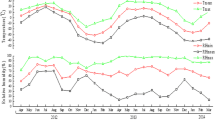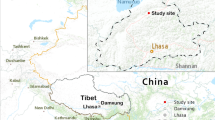Abstract
The ornate kangaroo tick, Amblyomma triguttatum triguttatum, was recently recorded on southern Yorke Peninsula, South Australia. We examined seasonal fluctuations in A. triguttatum triguttatum life stages (adult, larva, and nymph) and its distribution on the peninsula. We used in situ CO2 traps and dragging cloths to determine monthly fluctuations in free-living ticks at four sites at Innes National Park from January to December 2006, and to determine the tick’s distribution on wider Yorke Peninsula. At each site, 166 m2 of ground surface were directly sampled with cloths, representing 16 1-m2 CO2 stations and three 1-m-wide 50-m transects. Adult A. triguttatum triguttatum were present in January and February and from August to December, with a peak (n = 54) occurring in November. Larvae were present from February to August, with their highest density (n = 3067) detected in March. Nymphs were collected from January to April and from August to December, with the highest density (n = 61) detected in September. Overall, A. triguttatum triguttatum numbers were highest in March when larvae peaked, and few ticks were detected in January (summer) or July (winter). Ticks occurred at several sites on southern Yorke Peninsula, supporting their invasive status.




Similar content being viewed by others
References
Arricau-Bouvery N, Rodolakis A (2005) Is Q fever an emerging or re-emerging zoonosis? Vet Res 36:327–349
Barré N, Garris GI, Lorvelec O (1997) Field sampling of the tick Amblyomma variegatum (Acari: Ixodidae) on pastures in Guadeloupe; attraction of CO2 and/or tick pheromones and conditions of use. Exp Appl Acarol 21:95–108
Bull CM, Burzacott D (2001) Temporal and spatial dynamics of a parapatric boundary between two Australian reptile ticks. Mol Ecol 10:639–648
Bureau of Meteorology (2006) Monthly climate report—South Australian regional office [Online, accessed 23rd October, 2006]. URL: http://www.bom.gov.au/announcements/media_releases/sa/20060901.shtml
Cumming GS, Van Vuuren DP (2006) Will climate change affect ectoparasite species ranges? Glob Ecol Biogeogr 15:486–497
Department for Environment and Heritage (2003) Innes National Park management plan. Government of South Australia, Adelaide
Eisen L, Eisen RJ, Lane RS (2002) Seasonal activity patterns of Ixodes pacificus nymphs in relation to climatic conditions. Med Vet Entomol 16:235–244
Estrada-Peña A (2001) Forecasting habitat suitability for ticks and prevention of tick-borne diseases. Vet Parasitol 98:111–132
Falco RC, Fish D (1992) A comparison of methods for sampling the deer tick, Ixodes dammini, in a Lyme disease endemic area. Exp App Acarol 14:165–173
Garner MG, Longbottom HM, Cannon RM, Plant AJ (1991) A review of Q fever in Australia 1991–1994. Aust N Z J Public Health 21:722–730
Guglielmone AA (1990) Sites of attachment in Amblyomma triguttatum triguttatum Koch (Acari: Ixodidae) on natural hosts. Ann Parasitol Hum Comp 65:145–148
Guglielmone AA (1992) The effect of temperature and humidity on development and longevity of Amblyomma triguttatum triguttatum (Acari: Ixodidae). Bull Entomol Res 82:203–208
Guglielmone AA (1994) The seasonal occurrence of Amblyomma triguttatum triguttatum Koch (Acari: Ixodidae). Acarol 35:107–114
Guglielmone AA, Moorhouse DE (1986) The effect of photoperiod on the development of Amblyomma triguttatum triguttatum (Acari: Ixodidae). J Med Entomol 23:274–278
Jensen PM (2000) Host seeking activity of Ixodes ricinus ticks based on daily consecutive flagging samples. Exp Appl Acarol 24:695–708
Kermode M, Yong K, Hurley K, Marmion B (2003) An economic evaluation of increased uptake in Q fever vaccination among meat and agricultural industry workers following implementation of the national Q fever management program. Aust N Z J Public Health 27:390–398
Kitron U, Kazmierczak JJ (1997) Spatial analysis of the distribution of Lyme disease in Wisconsin. Am J Epidemiol 146:558–566
Koch HG, McNew WR (1982) Sampling of lone star ticks (Acari: Ixodidae): dry ice quantity and capture success. Ann Entomol Soc Amer 75:579–582
Korenberg EI (2000) Seasonal population dynamics of Ixodes ticks and tick-borne encephalitis virus. Exp Appl Acarol 24:665–681
Lord CC (2004) Seasonal population dynamics and behaviour of insects in models of vector-borne pathogens. Physiol Entomol 29:214–222
Maurin M, Raoult D (1999) Q fever. Clin Microbiol Rev 12:518–553
McDiarmid L, Petney T, Dixon B, Andrews R (2000) Range expansion of the tick Amblyomma triguttatum triguttatum, an Australian vector of Q fever. Int J Parasitol 30:791–793
Norval RAI (1977) Ecology of the tick Amblyomma hebraeum Koch in the Eastern Cape Province of South Africa. I. Distribution and seasonal activity. J Parasitol 63:734–739
Pope JH, Scott W, Dwyer R (1960) Coxiella burneti in kangaroos and kangaroo ticks in Western Queensland. Aust Exp Biol 38:17–28
Roberts FHS (1962) On the status of morphologically divergent tick populations of Amblyomma triguttatum Koch (Acarina: Ixodidae). Aust J Zool 10:367–381
Roberts FHS (1970) Australian ticks. CSIRO, Melbourne
Steere AC, Malawista SE (1979) Cases of Lyme disease in the United States: locations correlated with distribution of Ixodes dammini. Ann Intern Med 91:730–733
Szabó MPJ, Castro MB, Ramos HGC, Garcia MV, Castagnolli KC, Pinter A, Veronez VA, Magalhães GM, Duarte JMB, Labruna MB (2007) Species diversity and seasonality of free-living ticks (Acari: Ixodidae) in the natural habitat of wild Marsh deer (Blastocerus dichotomus) in Southeastern Brazil. Vet Parasitol 143:147–154
Acknowledgements
Thanks to our colleagues Ross Andrews and Bruce Dixon for their assistance with tick identification and microscopy, performed with the continuous support of Olympus Australia. We are greatly indebted to our dedicated research assistant Matthew Gill who spent many days in the field throughout the course of this research. We also thank: Robert Aebi, Katherine Brownlie, Sarah Buckley, David Carver, Peter Close, Alan Dickens, Christopher Havelberg, Michael Jervois, Serina Lattanzio, Larissa Lauder, Anna Llewellyn, Philip Roetman, Annette Scanlon, James Tomlinson, Ashley Walker, Hugh Waudby, Pam Waudby, Brian White, Michael Rosewarne and Janine Slocombe. Sincere thanks to the Northern and Yorke Region Department for Environment and Heritage staff. Thanks also to Ian Beveridge who provided comments on the manuscript; Robert Sharrad also made useful suggestions relating to the initial research. This research was funded by a University of South Australia Competitive Grant and a Nature Foundation of South Australia Scholarship. This research was conducted under a National Parks and Wildlife Scientific Permit K25073 2, and ethics approval (92/05) from the IMVS Animal Ethics Committee.
Author information
Authors and Affiliations
Corresponding author
Rights and permissions
About this article
Cite this article
Waudby, H.P., Petit, S. Seasonal density fluctuations of the exotic ornate kangaroo tick, Amblyomma triguttatum triguttatum Koch, and its distribution on Yorke Peninsula, South Australia. Parasitol Res 101, 1203–1208 (2007). https://doi.org/10.1007/s00436-007-0604-x
Received:
Accepted:
Published:
Issue Date:
DOI: https://doi.org/10.1007/s00436-007-0604-x




